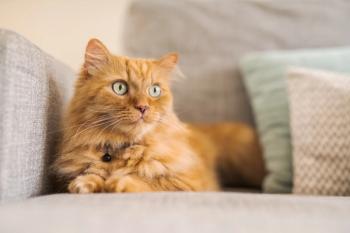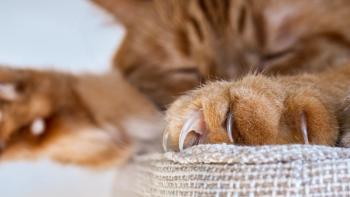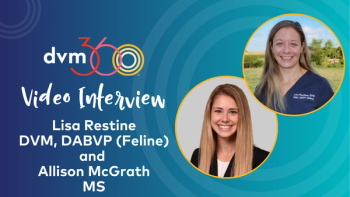
Diabetes mellitus: Rule out administration problems first in uncontrolled cats
Q: Could you review the causes and management of diabetes mellitus in older cats?
Q: Could you review the causes and management of diabetes mellitus in older cats?
A: To answer this important question I referred to the recentarticle: Rand J: Understanding feline diabetes and its management. Proc20th Annual Forum ACVIM 20:29-30, 32-34, 2002. An abbreviated summary ofthis article follows.
Causes
Diabetes mellitus in animals may be type 1, type 2, or other specifictypes. Type 1 diabetes is an uncommon cause of diabetes mellitus in cats.Type 2 diabetes appears to be the most common form of diabetes mellitusin cats and is characterized by inadequate insulin secretion and impairedinsulin action - commonly referred to as insulin resistance.
Altered pancreatic beta cell function is usually progressive and, insome cats, results in complete loss of insulin secretion. Few diabetic catshave other specific types of diabetes mellitus, previously called type 3diabetes. Various diseases are causes of the other types of diabetes mellitusresulting in non-specific destruction of pancreatic tissue. The most frequentdiseases are pancreatitis and pancreatic adenocarcinoma; neoplasia accountingfor up to 19 percent of feline diabetes mellitus cases. Extremely rare causesof naturally occurring insulin resistance in cats include growth-hormoneproducing tumors resulting in acromegaly and hyperadrenocorticism.
Iatrogenic administration of megestrol acetate or long-acting steroids(such as commonly used depo-medrol) is associated with the development ofdiabetes mellitus in some cats. It is quoted that diabetic cats are approximatelysix times less sensitive to insulin than normal cats.
Obesity, related factors
Obesity is a recognized risk factor for the development of diabetes mellitusin cats. Obesity decreases insulin sensitivity by one-half and, in someobese cats, insulin sensitivity decreases to even lower levels. Low insulinsensitivity results in hyperinsulinemia and eventually leads to beta celldeath. In some families of cats, there is strong evidence for a geneticbasis for the disease.
Environmental influences interact with genetic influences and play animportant role in the development of diabetes mellitus in cats. The lifestyleof many domestic cats has changed with physical inactivity and obesity increasingin urban cats.
Exclusively indoor cats are usually less active than outdoor domesticcats that hunt and defend their territory, and these cats are significantlyless active than feral cats that have to hunt for all their nutrition. Neuteredmale cats outnumber neutered female cats with diabetes mellitus by 1.5:1.Male cats are at greater risk of obesity than females.
When fed ad lib, male cats gain more weight than female cats. In addition,male cats tend to have lower insulin sensitivity than female cats when leanthat deteriorates further with weight gain. The propensity of male catsto have underlying low insulin sensitivity coupled with weight gain problemsmay explain their increased risk of diabetes mellitus.
In susceptible cats, the long-term demand for increased insulin secretionmay lead to beta cell destruction and a decline in insulin secretory capacity.
Many, but not all, cats with type 2 diabetes have amyloid depositionreplacing islets cells. Amyloid deposition does not appear to be an essentialcomponent of type 2 diabetes in cats but contributes to beta cell loss andfailure of insulin secretion. Islet amyloid is formed from the beta cellhormone amylin, which is secreted along with insulin. Formation of intracellularamylin fibrils is toxic to beta cells. Cats with high amylin concentrationstend to have more profound amyloid deposition.
Obesity likely contributes to amyloid deposition in susceptible catsby stimulating hyperamylinemia and hyperinsulinemia.
Once persistent hyperglycemia occurs, insulin secretion is reduced througha phenomenon referred to as glucose toxicity. The severity of this glucosetoxic effect is dependent on the degree of hyperglycemia and the duration.It is, therefore, vital that therapy be instituted as soon as possible toreduce hyperglycemia in diabetic cats if any beta cell function is to bepreserved. Therapy is also important because a substantial number of catswill undergo remission of their diabetes mellitus if the effects of glucosetoxicity are minimized.
Chronically elevated blood glucose also causes insulin resistance. Whenovert diabetes mellitus with persistent hyperglycemia occurs, the addedinsulin resistance further adds to the problem of inadequate insulin secretion.Once glucose concentrations are decreased with treatment, insulin sensitivitymay improve.
Diagnosis
The diagnosis of diabetes mellitus in cats is not simple. Clinical signs,such as polydipsia/polyuria, weight loss or polyphagia are non-specificand cannot be confirmed by physical examination. Diagnosis in cats is alsocomplicated by stress hyperglycemia, which in sick, non-diabetic cats maylead to glycosuria or blood glucose levels in excess of 360 mg/dl.
Blood glucose concentration in non-diabetic, unstressed cats is usuallyless than 180 mg/dl. When sampling blood, it is very important to avoidstruggling with the cat, because this will cause a transient hyperglycemia.Blood glucose concentration should be measured several hours after the firstsample to confirm persistent hyperglycemia, especially if the blood glucoseconcentration is 360 mg/dl or greater.
Signs of diabetes mellitus occur once blood glucose concentration exceedsthe renal threshold, which is approximately 288 mg/dl for most cats. Ifthere is doubt whether the hyperglycemia is transient, associated with stressor from diabetes mellitus in sick cats, it is prudent to begin insulin therapyand monitor glucose concentrations carefully for the next few days. Reducingglucose concentrations with exogenous insulin reduces the suppressive effectof glucose toxicity and makes recovery of beta cells more likely.
Controversial approach
The approach outlined next is much more controversial. Because glucosetoxicity can reduce insulin secretion in normal cats to levels of insulin-dependentdiabetic cats within three to seven days, do not wait to begin insulin therapyif blood glucose concentration is 270 mg/dl or higher. Likewise, in catswith iatrogenic or spontaneous hyperadrenocorticism or acromegaly, begininsulin therapy immediately to preserve remaining beta cells. Therapy forthe underlying disease can then be instituted and glucose concentrationsmonitored to adjust insulin dose. Do not wait to see if the diabetes resolvesonce the underlying disease process is treated or the exogenous hormoneeliminated, because this makes permanent diabetes mellitus more likely.
Control signs
Treatment of diabetic cats is to control the clinical signs of diabetesmellitus, such as weight loss, polydipsia/polyuria, and polyphagia or inappetence,and to prevent diabetic ketoacidosis. Additionally, one wants to reducethe risk of hypoglycemia by appropriate dose adjustment of insulin or oralhypoglycemic agents. Although currently it is not possible at diagnosisto predict which cats are more likely to go into remission, appropriatetherapy may lead to diabetic remission.
Nutrition
In cats, postprandial hyperglycemia is mild but very prolonged, up to18-24 hours, in cats fed typical cat foods. The initial increase in bloodglucose concentration occurs about two to four hours after eating. Therefore,it is not necessary to match the timing of the insulin administration tomeals. Once eating normally, a diabetic cat with a healthy body weight shouldbe fed a good quality feline diet free choice to maintain its healthy bodyweight. A high protein, low carbohydrate diet is advantageous, such as afeline growth diet, in the hyperglycemic cat. When the diabetes mellitusbecomes stabilized with therapy, body weight often increases. If the catstarts to become overweight, calories should be restricted to maintain idealbody weight.
Alternatively, the cat could be changed to a moderately calorie-restricteddiet, such as a geriatric diet, or a diet for less-active cats, althoughthese tend to have higher levels of carbohydrate.
Oral medication
About 5-30 percent of diabetic cats achieve good clinical control withoral hypoglycemic drugs. Glipizide is the only hypoglycemic drug with well-documentedeffectiveness in the treatment of diabetic cats. The dosage of glipizideis 2.5 mg twice daily, regardless of the body weight of the cat. Becauseglipizide may cause transient elevation of serum liver enzymes and in somecases icterus, monitoring of serum liver enzymes is recommended during glipizidetreatment.
Insulin types
The preferred treatment in diabetic cats is injectable insulin. The choiceof insulin for the diabetic cat centers around minimizing the number ofinjections required each day while still achieving adequate diabetic control.
Insulins used for daily maintenance are those either of intermediateduration (lente or NPH) or long-acting duration [ultralente or protaminezinc insulin (PZI)]. Despite the variation in insulin types used, no correlationhas been found between the type of insulin and diabetic control.
Hypoglycemia most likely occurs in the first four months after beginninginsulin therapy. It can be life threatening. Cats should be carefully watchedfor evidence of hypoglycemia (dazed, trembling, weakness, wobbly gait, seizuresand coma) and the insulin dosage decreased.
The lente insulins have a more predictable onset and duration of effectin cats than the longer-acting insulins.
Porcine lente insulin is available in many countries as a proprietaryveterinary product. Porcine lente insulin is administered twice daily inall diabetic cats. The recommended starting dose is 0.25-0.5 unit per kgbody weight.
NPH insulin has a similar but slightly shorter duration of action thanlente insulin and usually is administered twice daily. Human ultralenteinsulin can be used once daily in many cats, but most cats will requiretreatment twice daily. The long-acting insulin PZI insulin is availableas a veterinary product (40 U/ml, IDEXX). It can be used once daily in somecats, but should typically be administered twice daily. As with other long-actinginsulins, it has a more variable onset and duration of action than shorter-actinginsulins. Prolonged marked hypoglycemia may occur in some cats on PZI insulin,and in some cats, glycemic control is poor. PZI insulin is particularlyuseful for cats in which the duration of action of lente insulin is tooshort to give adequate glycemic control, and when owners are unwilling togive twice-daily injections.
Many cats have reasonable clinical control with PZI insulin, but catsthat do not achieve good control should be tried on shorter-acting insulinsuch as lente insulin, before the poor control is attributed to insulinresistance.
In some cats, blood glucose concentration does not decrease significantlyand control of clinical signs is poor when using the longer-acting insulins(human or bovine ultralente or PZI insulin), even when dosages of 1 U/kgor greater are used. A change to a better absorbed, shorter-acting insulin(lente or NPH) may improve diabetic control in these cats.
The new insulin analogue, insulin glargine (Lantus), is long-acting andreleased for human use. Initial information shows that like other long-actinginsulins, there is considerable variation between cats and within the samecat in onset, duration and degree of action. Also, prolonged hypoglycemiais a risk. In cats, insulin glargine is not peakless. Initial informationindicates it is likely useful in diabetic cats and can be given once ortwice daily depending on the individual cat. However, duration of actionis not significantly different from PZI insulin in normal cats. Startingdose rates are 0.25 U/kg twice daily or 0.5 U/kg daily. Prolonged hypoglycemiais possible with long-acting insulins, and cats should be monitored carefullyto avoid hypoglycemia.
Starting dosage
The type of insulin chosen and baseline blood glucose concentration ofthe cat determine the initial dose of insulin. Insulins that have a longerduration of action do not tend to lower the blood glucose concentrationas much as the same dose of shorter-acting insulin.
The recommended starting dose is 0.25-0.5 unit per kg body weight. Theblood glucose response should be re-evaluated every two to four weeks (orimmediately if clinical hypoglycemia occurs) until good control is attained.If clinical hypoglycemia occurs, the insulin dose should immediately bedecreased by 50 percent, and a serial blood glucose curve performed forthe new dose. If lente or NPH insulin is being used and diabetic controlis poor, two circumstances may warrant a change to longer-acting insulin(ultralente or PZI insulin). Consider the change if:
* the insulin is having a rapid peak of action (within two tothree hours) and a short duration of effect (six to seven hours),
* and/or if a low nadir blood glucose is occurring despite theaverage blood glucose concentration remaining high.
Monitoring diabetics cats
Evidence for good clinical control includes an active cat with a healthyappearance, a stable body weight, and levels of polydipsia and polyuriaacceptable to the owner and veterinarian. Water intake can be measured athome or in the hospital, and is a better indicator of average blood glucoseconcentration than serum fructosamine concentration.
Water intake may vary substantially from day to day; therefore, measurementof water intake for more than a single day, preferably over a week, shouldbe done. A water intake of less than 20 ml/kg body weight daily indicatesexemplary diabetic control.
Most cats with good control drink less than 80 ml/kg body weight daily.Other clinical signs, such as a stable body weight and the presence or absenceof lethargy, should also be monitored. Making insulin dosage rate changeson the basis of serum fructosamine measurements should be done with caution,as the serum fructosamine level does not give an indication of the nadirblood glucose concentration.
However, serum fructosamine level may be a useful marker where stressor fractiousness makes an accurate serial blood glucose curve unobtainable.
Urine glucose also does not give information about how an insulin dosageshould be changed, and is most useful for indicating or predicting diabeticremission. If the cat becomes aglycosuric, this may indicate diabetic remissionhas occurred. And, the insulin administration can be discontinued for severaldays while the urine glucose is monitored daily. If glycosuria recurs, itmay be necessary to perform a serial blood glucose curve to determine thesubsequent insulin dose.
Uncontrollable cats
When cats treated with insulin fail to stabilize, a number of underlyingcauses and approaches to treatment should be considered. It is importantto remember that many cats take one to four months to stabilize. The temptationto "over-adjust" the insulin dosage should be avoided.
It is unrealistic to expect good glucose control after only two to fourweeks of diet and insulin treatment. The most common problems resultingin poor glucose control are excessive dose, miscalculation of dose, tooshort duration of insulin action or poor absorption of insulin. Some catsare mistakenly labeled problem cats when the clinical signs are well controlled,but blood glucose measurements are less than ideal.
If the glucose nadir is below 182 mg/dl after each insulin injection,peak action occurs more than three hours after administration and hypoglycemiais not occurring, glycemic control is usually adequate. These cats usuallyhave good clinical control (stable body weight, good coat condition, active,alert, water intake less than 100 ml/kg daily).
Uncontrolled cats have persistent clinical signs including polydipsia(water intake of more than 100 ml/kg daily), low body condition score, polyphagia,lethargy and a poor hair coat; an insulin dose higher than normal (1.5-2.0or more U/kg per injection); and either a nadir glucose more than 180 mg/dlor hypoglycemia.
For problem-solving in uncontrolled cats, it is important to first ruleoutadministration problems - expired insulin, heat-affected insulin (such asleft in a car in summer), poor mixing of suspensions, failure of administration(injecting through the skin pinch onto the hair coat), and the presenceof air bubbles in the syringe causing a lower administered dose. Insulinsyringes can be difficult to manage for elderly owners with arthritic handsand poor vision. These owners are often better able to cope with insulinpens. Misunderstandings between the owner and veterinarian regarding thenumber of units to be administered can cause problems.
If the cat has been treated for at least eight to 12 weeks and insulinis being correctly administered but poor control is still evident, measurewater intake over consecutive days at home (measure serum fructosamine concentrationif water intake cannot be measured), and obtain a blood glucose curve.
Poor control may result from an excessive insulin dosage, and cause apparentinsulin resistance (dosage is greater than 1.5-2.0 units per injection withpersistent hyperglycemia) or short duration of insulin action.
If the cat is polydipsic and insulin seems to have little effect, especiallywhen previously it caused substantial lowering of glucose, or the durationof action seems to be short, it is safer to first try lowering the doseof insulin to 0.3-0.5 U/kg for 10-14 days to see if blood glucose or waterintake improve. This is particularly useful in cats on potent insulins suchas lente or NPH insulin.
If clinical control is not improved with a lower dose, check the bloodglucose response to a standard dose of 0.5 U/kg of insulin, to determinethe duration of effect. If the blood glucose nadir occurs two to three hoursafter injection, switch to a longer-acting insulin or increase the frequencyof administration to three times daily.
Similarly with PZI insulin, if the nadir occurs at less than six hours,change to twice-daily administration if the cat is receiving insulin oncedaily. With PZI or ultralente insulin, if there is little response, tryusing lente or NPH insulin as some cats seem to have poor absorption withthe longer-acting insulins.
If there is still polydipsia (water intake is more than 100 ml/kg daily)and little glycemic response to a more potent insulin, check the cat forhyperthyroidism, hyperadrenocorticism, acromegaly or other systemic diseasesuch as renal failure. Glycemic control may improve in cats with periodontaldisease following dental procedures in combination with short-term antibiotics.
In the meantime, increase the dosage by one unit every two weeks untilsome glycemic response is achieved. Warn the owner that a severe hypoglycemicepisode can occur with this approach and to be vigilant regarding the earlysigns (lethargy, mental dullness, wobbliness, trembling and dilated pupils).
Newsletter
From exam room tips to practice management insights, get trusted veterinary news delivered straight to your inbox—subscribe to dvm360.






